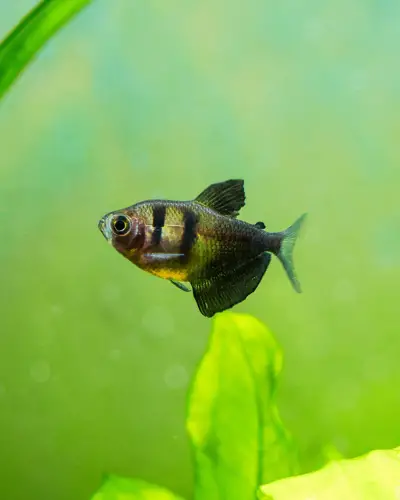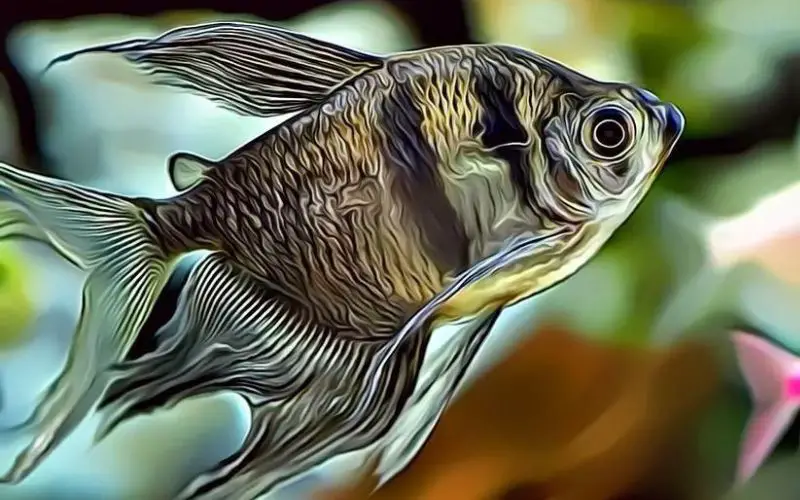The Black Skirt Tetra, also known as Gymnocorymbus ternetzi, is a popular freshwater fish known for its striking black markings and graceful swimming behavior. But what do black skirt tetra eggs look like?
One of the most fascinating aspects of this fish is its reproductive cycle, particularly the egg-laying and hatching process.
In this article, we will explore the life cycle of Black Skirt Tetra eggs, from the initial spawning to the development of the embryos and eventual hatching of the fry.

The spawning behavior of Black Tetras typically begins with a courtship display between a male and female, culminating in the female releasing her eggs, which the male then fertilizes. These eggs are adhesive and will attach to plants or other surfaces within the aquarium.
Over a few days, the eggs will develop and eventually hatch into tiny fry. Join us as we delve into Black Widow Tetra eggs’ intricate and fascinating journey from spawning to hatching.
Table of Contents
ToggleDo Black Skirt Tetras Lay Eggs or Give Live Birth?
Black Skirt Tetras lay eggs, which means they release their eggs freely into the water column. The male fertilizes the eggs externally, and the eggs are not attached to any substrate.
Black skirt tetras can be prolific breeders, and a single spawning can produce up to 1000 eggs. However, the eggs are very small and susceptible to being eaten by the parents or other fish in the tank.
If you want to breed black skirt tetras, you must set up a separate breeding tank and remove the parents after they have spawned.
Are Black Skirt Tetra Egg Scatterers?
Yes, Black Skirt Tetras are egg scatterers. They belong to the group of fish that reproduce by releasing eggs freely into the water for external fertilization.
This means the male releases milt (sperm) to fertilize the eggs after the female releases them in the water column. The parents do not care for the eggs, which are susceptible to being eaten by other fish.

Black tetra gymnocorymbus ternetzi can be kept in community aquariums with other peaceful fish species like cichlids, angelfish, or Neons. They are generally peaceful themselves but can sometimes exhibit slightly aggressive behavior toward other fish with similar body shapes.
If you want to start breeding black skirt tetras in your aquarium, you must provide them with adequate fry food and ensure that the tank has enough hiding places for the fry to seek refuge from other fish.
The male black skirt tetra will actively guard the eggs and fry, so providing a peaceful environment is essential for the process to succeed.
What Do Black Skirt Tetra Eggs Look Like?
The black skirt tetra eggs are small and transparent, looking almost like tiny grains of rice. The male fertilizes them, then scatters them by the female black skirt tetra in the aquatic environment.
Once the eggs hatch, the fry must be large enough to eat, so providing live and frozen foods like brine shrimp is essential. The newly hatched fry of the black skirt tetra will also swim around seeking hiding places in the tank. It’s important to note that tetras are schooling fish and should be kept in groups of at least six.
Adult fish often prey upon the fry of the black skirt tetra, so it’s essential to provide plenty of cover, such as plants or even snails, in the tank.
To ensure the fry’s survival, an aquarist can separate them into a separate tank until they are large enough to be introduced into the community tank. Additionally, feeding them small live foods or crushed fish will help them grow quickly.
Life Cycle OF Black Tetra eggs:
The life cycle of Black Skirt Tetra eggs, from spawning to hatching, is relatively quick. Here’s a breakdown of the key stages:
Spawning:
- Triggered by specific water conditions like slightly acidic pH, softer water, and a slight temperature increase.
- The female releases a batch of small, transparent eggs (usually around 100-200) into the water column.
- The male follows closely behind, fertilizing the eggs with his milt.
Development:
- The eggs are not sticky and won’t attach to anything. They drift freely in the water current.
- Each egg has a small oil globule that helps it float near the water’s surface.
- Development is rapid and influenced by water temperature. At ideal temperatures (around 75°F), hatching can occur within 24-48 hours.
Hatching:
- As the embryo develops inside the egg, a tiny Black Skirt Tetra fry becomes free swimming (baby fish) and starts to form.
- Shortly before hatching, the fry’s eyes become visible.
- The fry breaks out of the egg sac, entering the world as a free-swimming organism.
Black Skirt tetra Tank setup & tank mates:
Black tetras require a well-maintained tank setup with proper care to thrive. It is essential to keep the water quality high and provide hiding places for the fish.
Consider adding neon tetras, white skirt tetras, or guppies as tank mates when setting up their tank. Black skirt tetras prefer to be kept in groups, and they will scatter their eggs in the aquarium where you own them.
The eggs will hatch within a few days, and the newborn fry can be fed with infusoria or vinegar eels. To ensure they are well-fed, you can feed them several times daily with flake or food.
Breeding Black Skirt Tetras
Breeding Black Widow Tetras can be a rewarding experience for aquarium fish hobbyists. Native to the rivers of Paraguay and Bolivia, these black vertical striped tetras are peaceful community fish that thrive in groups.
When breeding, it is essential to keep them in groups to prevent fin-nipping behavior. Males can be distinguished from females by their rounder and plumper body shape. The males also have more intense coloration, especially during breeding periods.
To encourage spawning, provide a spawning aquarium with plenty of live plants and flowing anal fins. After the eggs are laid, they will hatch in about 36 hours, and the fry can be fed with newly hatched brine shrimp.
It is recommended to do regular water changes to keep the aquarium water clean, which will darken the anal and dorsal fins of gravid females.
Spotting a Pregnant Black Skirt Tetra Eggs
Black Skirt Tetras, don’t get pregnant! Since they’re egg scatterers, they don’t carry fertilized eggs inside their bodies. However, you can identify a female Black Skirt Tetra that’s ready to spawn (release eggs) by looking for a few key signs:
- Increased Belly Size: The most noticeable sign is a noticeably plumper belly compared to females or males. This bloating is due to the development of mature eggs inside her.
- Rounded Body Shape: A female preparing to spawn will have a rounder body shape, not just in the belly area. This is because her body cavity is filled with maturing eggs.
- Change in Behavior: Sometimes, a gravid (full of eggs) female might become more withdrawn or secretive, hiding more within plants.
- Observing the Group: If you notice a particular female being chased around by males, this could be a sign she’s full of eggs, and the males are trying to trigger spawning.
- Comparison with Other Females: Observing the group and comparing the body shapes of different females is the best way to identify a potential spawner.
- Remember: These signs can be subtle, and a slightly plump belly doesn’t guarantee a female is full of eggs. If you’re looking to breed Tetras, observing their behavior and overall health within an adequately set-up breeding tank is best.
Commonly Asked Questions about Black Widow Tetra Eggs (FAQs)
How can u tell if black skirt tetra is laying eggs?
You can’t directly see Black Skirt Tetras laying eggs. But watch for increased chasing, especially of a plump female with a round body. This suggests spawning is happening!
How do black skirt tetra lay their eggs?
The female black tetra releases eggs freely into the water while the male fertilizes them externally. These tiny eggs drift and hatch within 48 hours.
How do you know if a tetra has eggs?
Look for a noticeable plumper belly and rounder body shape in a female Black Skirt Tetra. This bloating indicates eggs are maturing for spawning.
What color are tetra eggs?
Tetra eggs are transparent! Since they are fertilized externally in the water, they are very small and clear to avoid being seen by predators.
How to tell the gender of a black skirt tetra?
Telling Black Skirt Tetra males from females can be tricky. Look for a plumper body in females, especially the belly. Males might be slimmer and show occasional white dots on the tail fin. Young fish may need to be more challenging to distinguish.
How do tetras lay eggs?
Tetras are egg-laying fish. Females release eggs into the water or plant leaf, which males then fertilize. The eggs are typically laid on plants or other surfaces in the aquarium.
What does a pregnant tetra look like?
A pregnant tetra will have a noticeably rounder abdomen than usual. The belly may appear swollen or even slightly square-shaped. You may also see a slight darkening of the abdomen area.
What fish use spawning mops?
Egg-scattering fish like tetras, barbs, and angelfish use spawning mops to lay eggs on. The mop provides a haven for the eggs.
Conclusion
In conclusion, the journey of the Black Widow Tetra Eggs is a fascinating spectacle that showcases the wonder of life. From the careful preparation of the breeding tank to the careful monitoring of water conditions, witnessing the hatching and development of these tiny eggs is a rewarding experience for any aquarium enthusiast. The dedication and patience required to raise Black Skirt Tetra fry successfully is a testament to the commitment of aquarists to providing the best care for their aquatic companions.
As the fry grow and flourish, they bring the hobbyist a sense of accomplishment and joy. Nurturing Black Skirt Tetra eggs is educational and a reminder of the incredible cycle of life within our aquariums. So, if you’re ready to embark on an enriching journey, consider breeding Black Skirt Tetras and be captivated by the magic of new life unfolding before your eyes.
Recommended Posts
- Colored White Skirt Tetra Fish 101: Size, Lifespan & More!
- TOP 7 Best Black Skirt Tetra Tank Mates (Experts Advice)
- 3 Tips to Extend Black Skirt Tetra Lifespan in the Fish Tank
- Is My Black Widow Tetra Pregnant or Just Bloated: (Solved)
- Black Tetra Breeding 101: (A Comprehensive Guide)




